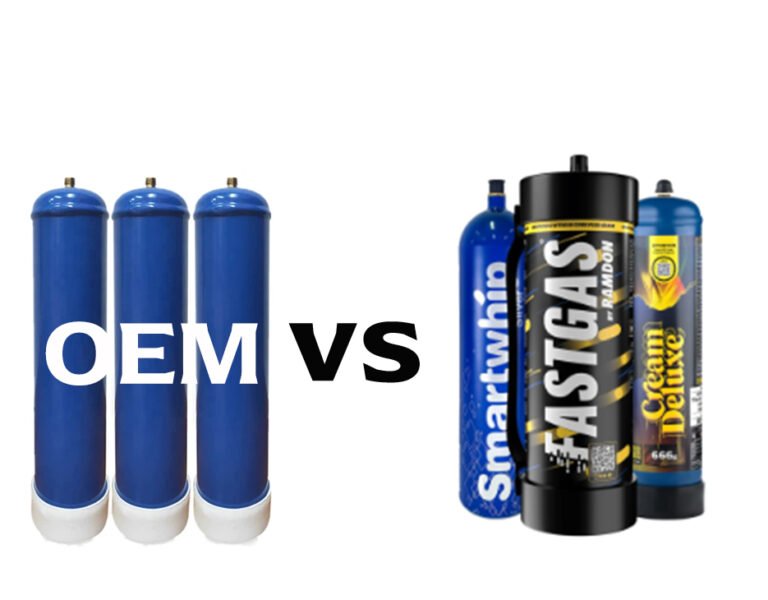Many distributors start by reselling big-name cream chargers. It’s fast and seems reliable. But behind that convenience lies a hidden ceiling.
OEM branding gives you full control of packaging, pricing, and channel growth—while unauthorized resale puts you at risk of customs holds, platform bans, and shrinking margins.

This guide compares both sales paths—based on actual risks, margins, startup costs, and long-term brand value. It’s not theory. It’s how experienced distributors grow.
Why Some Distributors Still Choose to Sell Big Brands
For many first-time importers, selling Smartwhip, FastGas, or GreatWhip feels safer. The brand is already known. Retailers accept it. Some even ask for it.
Reselling big brands means lower upfront work: no need to design boxes, test flavors, or explain what N2O is.
Common reasons buyers choose this path:
- No need to invest in branding/design
- Easy to onboard retailers quickly
- Low risk of failed packaging aesthetics
- Belief: “It will sell itself”
But if the brand isn’t yours—you don’t control the pricing, supply, or customer base. You’re always replaceable.
The Real Legal and Platform Risks of Unofficial Resale
Selling a big brand without written authorization is not just “unofficial”—it’s risky.
You expose yourself to customs seizure, Amazon delisting, Stripe payment holds, or direct legal letters from brand owners.
| Risk Point | Real Example |
| Trademark infringement | UK border force seizing Smartwhip shipments |
| Platform suspension | Amazon flagging FastGas under brand protection |
| Payment gateway risk | Stripe freezing payouts due to counterfeit claim |
| Resupply disruption | Suppliers cutting off access after brand complaints |
Many big brands (like Smartwhip) use brand monitoring tools and Amazon Brand Registry to detect unauthorized listings. Even if you bought from a “gray market” channel, your name is on the invoice.
What OEM Branding Unlocks: Control, Margin, and Customization
OEM isn’t just “putting your logo on the box.” It’s about owning your pricing, your packaging, and your customer relationship.
A properly set up OEM brand lets you decide how it looks, how it’s priced, and who gets access.
What OEM enables:
- Logo + packaging aligned to your channel
- Flavors/language mix by country (EN/FR, DE/NL, etc.)
- Batch control for warranty or logistics
- Direct relationship with factory—no middlemen
- Region exclusivity if volumes match
Want to see what’s customizable? View our OEM-ready N2O options →
Profit, Risk, and Scalability: Sales Models Compared
| Factor | OEM Brand | Resell Big Brand |
| Margin per unit | Higher (you control pricing) | Lower (brand sets pricing) |
| Label/box control | Full (you choose design) | None |
| Legal risk | Low (your IP) | High (if unauthorized) |
| Channel adaptability | Full (multi-country use) | Limited to brand license |
| Supply chain control | Direct from factory | Variable |
| Platform security | Safe (your brand not blacklisted) | Risky on Amazon, eBay |
| Brand value over time | Builds your asset | No long-term equity |
📌 Many distributors earn 15–20% more per box after switching to OEM—because they set the rules.
When Is the Right Time to Switch from Reselling to OEM?
Switching too early leads to excess cost. Switching too late means missed margins. Watch for these signs:
✅ You Should Switch to OEM If:
- Retailers start asking: “Can we get your brand instead?”
- Your supplier changes price without notice
- Other sellers offer the same SKU, cheaper
- You’ve sold >5,000 pcs/month for 3+ months
- You’re blocked by platforms for brand misuse
📌 If your business already handles logistics and communication with retailers, OEM is your next logical step.
OEM Startup Costs, MOQ, and Timeline Explained
You don’t need 50,000 units or a branding agency to start. Here’s what most OEM factories require:
| Item | Typical OEM Setup |
| MOQ | 5,000–10,000 pcs |
| Logo file | Vector format (AI, CDR, PDF) |
| Sticker or printed box | Both options available |
| Flavor mix | Allowed by pallet (e.g. 5+5) |
| Lead time | 18–25 days after layout confirm |
| Box language | Any (EN/FR, DE/NL, etc.) |
| Export compliance | CE, TPED, FDA printed & certified |
📌 Most serious factories help with layout design at no cost. You don’t need a designer to begin.
What to Write in Your Factory Contract to Protect Your Brand
OEM comes with responsibility. You must set clear terms with your supplier.
What to include in your PO or OEM agreement:
- Label scope: “Only apply buyer’s logo to this model/flavor.”
- Brand protection: “Supplier shall not mix or disclose buyer’s brand to third parties.”
- Replacement clause: “>1% leakage can be deducted or replaced in next shipment.”
- Artwork rights: “Buyer retains exclusive rights to final layout.”
- Territory limits (if needed): “Exclusive for AU/NZ until 2026, min. 3 containers/year.”
📌 Don’t rely on trust. Use simple language in your PO to confirm every key term.
Conclusion
You can’t build long-term profit by selling someone else’s brand. Smart distributors use resale to start—but OEM to scale. If you want to own your market, your margin, and your message, it’s time to move from fast resale to strategic branding.




